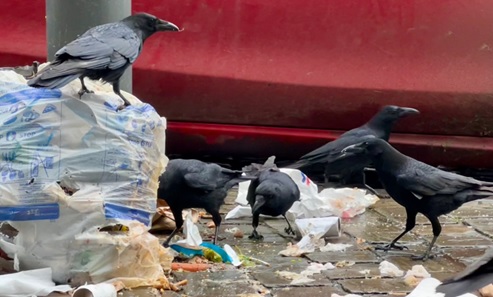28-06-2022
Why and how crows have colonised the world?
Barcelona, June 28th 2022. Humans, crocodiles and crows have something in common. They have all spread to every corner of the planet. If we travel from Barcelona to Australia, in spite of the enormous distance, we will find groups of animals that also live in our home, we will see for example owls, swallows, turkeys, crows and... Certainly humans, all these animals are so far away because they have been able to colonise the planet almost entirely. But what is it that they have been able to do so while other animal groups have been reduced to small areas of the planet?
A study co-led by Washington University in St. Louis and CREAF has focused on crows to answer this question. One of the conclusions of the study was that crows could have colonised the planet thanks to their ability to fly long distances, a large body and using intelligence to solve problems and obtain new resources from each environment. For CREAF researchers Daniel Sol Rueda and Joan Garcia-Porta, the former also a CSIC researcher and the latter now in the Biodiversity Research Institute (IRBio) the Department of Genetics, Microbiology and Statistics at the University of Barcelona, these three characteristics have coincided in the crow group and have allowed them to reach remote places, survive in all kinds of environments and adapt to them successfully. What has been the consequence of this global expansion? An outstanding diversification. The study shows that crows, while spreading around the world, produced new species at an exorbitant rate: more than 40 different species in just ten million years, species that changed body size and beak shape to adapt to new environments.
To reach these conclusions, the research team conducted an exhaustive analysis of a multitude of ecologically relevant traits: wing size, beak volume and shape, body dimensions and brain size. To do this, the team visited museums around the world to measure and compare skeletons of many species of corvids (the crow family, which also includes jackdaws, magpies and jays, among other species). "Natural history museums are incredible places, true archives of biodiversity. In a small space you can see and compare a multitude of different species, many of them from distant corners of the planet," explains Joan Garcia-Porta, also a member of the UB's Institute for Biodiversity Research (IRBio).
In parallel, the phylogenetic tree of the corvid family has also been remade with genetic data to incorporate as many species as possible. By combining phylogenies and morphological traits, it has been possible to check whether these traits, as well as helping to colonise the world, also accelerated the creation of new species.
Flying machines
The results of the study show that crows have relatively longer wings than other corvids and larger body sizes. This allows them to fly long distances and, once they arrive at a new site, to be competitively superior. Being good fliers also helps them to move by chance to remote locations, which sharply decreases genetic exchange between populations and facilitates the generation of new species.
In addition, each new location may have different conditions than the previous one, to which the species has had to adapt, modifying its morphology for each new condition. This explains why, as crows have spread around the world, the number of species has increased rapidly, producing a huge variation in body size and beak shape.
Unique intelligence
A colonising animal must be able to survive in new environments that are probably very different from those of origin, from arctic zones to desert areas. What morphological characteristic makes it easier to be more or less able to adapt to a new environment? Daniel Sol's research group has been working on this question for many years and they are very clear about it: the size of the brain. "Intelligence in animals is demonstrated when an individual is able to solve challenges and overcome the limitations or mismatches that occur when changing environment. This implies having a larger relative brain size, because it has been shown to be related to having more cognitive abilities and a lot of behavioural flexibility, a well-known characteristic of crows", according to Daniel Sol.
With this in mind, the team measured the volume of the brains of more than 76 species of crows and other corvids. The results were as expected, with crows having a larger relative brain size than other corvids. "The fact that they have larger brain sizes shows that crows may have greater cognitive abilities than other corvids, which allows them to have the adaptability to occupy environments as different as the Arctic tundra and Australian deserts," explains Joan Garcia-Porta.
More than 3,000,000 observations
The researchers also wanted to check whether crows were indeed able to live in climatic zones where no other corvids live. To do so, they extracted more than three million observations of corvids from the citizen science platform eBird. This gave information about the climate space where the crows lived (where they had been observed), and they could compare it with the climate space of other corvids. The results, once again, showed that ravens occupied a much wider climatic range than all corvids combined and that, apart from replicating the climate space occupied by other corvid species, they reach much more extreme climatic zones where no corvid can survive.
"Crows offer us a fantastic opportunity to understand why certain organisms spread and diversify across the planet. We are one of these organisms and, therefore, understanding the processes of global expansion in other groups of animals could shed some light on our own journey around the planet," concludes Joan Garcia-Porta.
Reference:
Niche expansion and adaptive divergence in the global radiation of crows and ravens. Joan Garcia-Porta, Daniel Sol, Matt Pennell, Ferran Sayol, Antigoni Kaliontzopoulou & Carlos A. Botero. Nature Communications, 2022.
doi: https://doi.org/10.1038/s41467-022-29707-5
Source:PressUB
Source:PressUB
